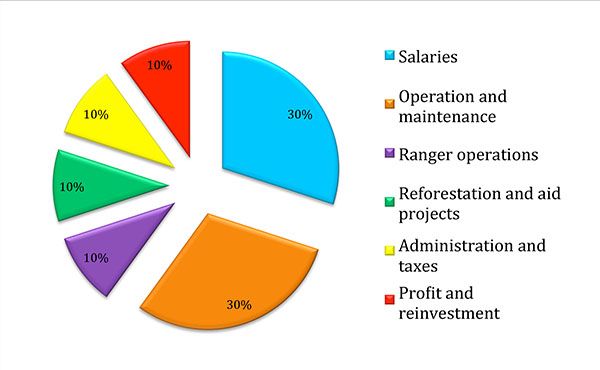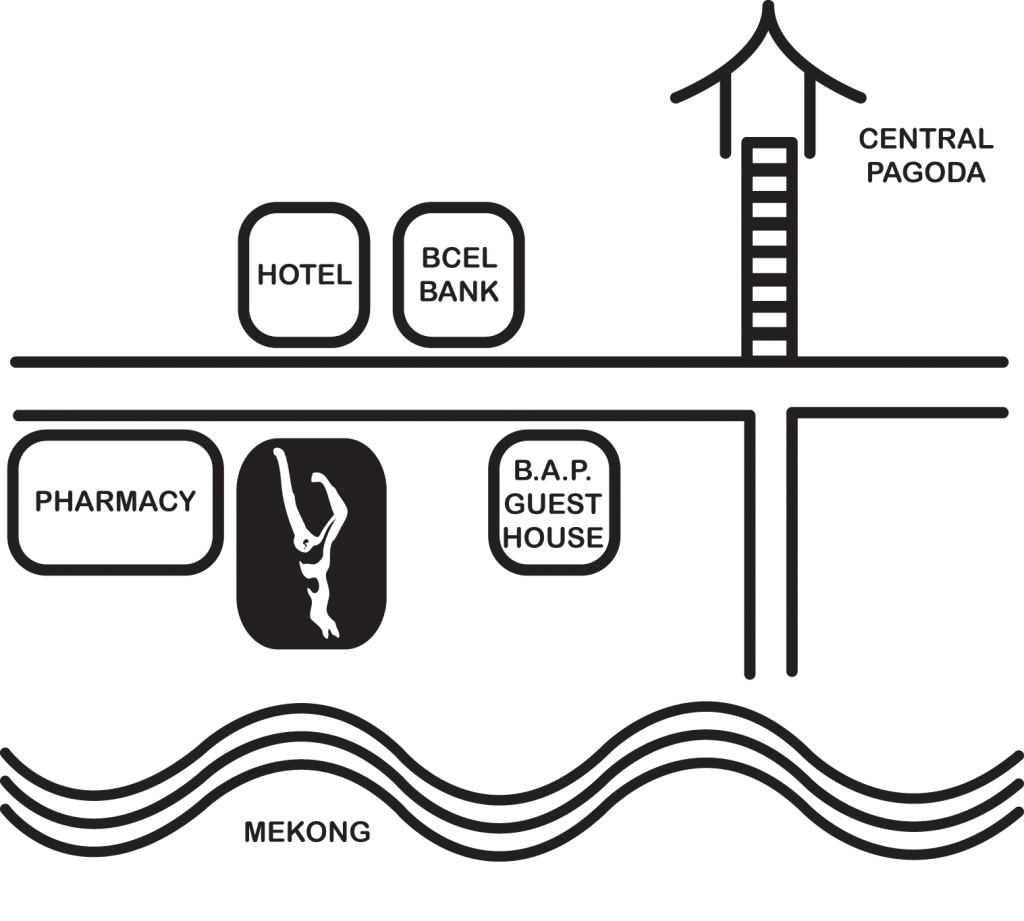From abroad, Chiang Rai is the fastest and easiest way to reach the start of the tour in Houayxai.
Regular buses leave Chiang Rai central bus station for Chiang Khong (opposite Houayxai) every hour or so for a 2-hour drive.
The border crossing is open every day from 8 to 20:00.
Make sure to cross the border the day before you start your tour.
From the border crossing, on the Lao side, you will have to take a tuk-tuk to come to our office located right in the center of Houayxai.
——————————————————————————–
Should you want to head to Chiang Rai on the same day your tour finishes, taking a taxi is the only option. You can arrange this by securing a ticket through a travel agent located on our street.
You can otherwise spend the night in Houayxai and take the regular bus the next day. They leave Chiang Khong bus station (opposite Houayxai) for Chiang Rai every hour, with a last bus at 15:00, for a 2-hour drive.
For Chiang Mai, you can travel first to Chiang Rai and connect from there.
The border crossing is open every day from 8 to 20:00.
There is no direct flights to Houayxai, instead you may fly to Luang Namtha.
Flights take 50 minutes and costs around 800,000 kips. Check exact flight schedule with Lao Skyway or Lao Airline as departure time may vary. Board the shuttle (200,00 kips) to Houayxai upon landing in Luang Namtha.
The fast train leaves Vientiane at 13:30 and reaches Nateuy at 17:03 while for the regular train it’s 8:42 – 13:28.
From Nateuy station, you can take a minibus (about 210,000 kips) to Houayxai (4 hours).
Check “How do I join from Louang Namtha” for more information.
Alternatively, daily buses leave at 17:00 from Vientiane Northern bus station; it takes about 22 hours.
Since 2024, you may also fly to Tong Pheung airport which is only one hour away from Houayxai, but the ticket price is about double.
—————————————————————————————–
You can book a train ticket from Houayxai near our office. The minibus to Nateuy train station takes 4 hours.
The regular train leaves at 15:03 and arrives in Vientiane at 20:04, the fast train leaves at 18:03 and arrives at 21:08.
From Luang Prabang (LP), you may either join Houaysai by train, bus or boat.
The regular train leaves LP at 11:32 and reaches Nateuy at 13:28 while the fast train departs at 15:36 and arrives at 17:03.
From Nateuy, you can take a minivan available outside the station to Houayxai (4 hours). Tickets for the minivan (LAK210,000) can only be purchased on site at the counter.
The night bus leaves LP bus station early evening. Travel time to Houayxai is about 12 hours. Beware: this is the least reliable form of transport, as the bus often breaks down en route or arrives too late.
If you cruise up the Mekong River with a slow boat (about 400 000 kips), travel time is two days with an overnight stay in Pak Beng. The speedboat option takes about 6 hours; the cost is about 8M kips for about 8 passengers. It does not always operate. Make sure you join the pier (located 10 minutes upstream LP) at 8 am to maximize your chances.
From Houayxai, the slow boat leaves at 9:00. Tickets are purchasable in hostels and hotels around our office.
The sleeping bus to Luang Prabang leaves Houaysai bus station at 17:30 and costs 430,000 LAK.
The regular trains depart Nateuy train station at 15:03 and arrives in Luang Prabang at 17:03 while for the fast train it’s 18:03 – 19:22.
From Vang Vieng, we recommend taking the train to Nateuy and then a minivan to Houaysai.
The regular train leaves at 10:32 and reaches Nateuy at 14:23 while the fast train departs at 13:57 and arrives at 16:23.
From Nateuy, minivans are available outside the station to Houaysai (4 hours). Tickets for the minivan (LAK210,000) can only be purchased on site at the counter.
From Houaysai, you can take a minivan to Nateuy train station.
The regular train leaves Nateuy at 15:55 and arrives at 19:15 in Vang Vieng, while the fast train leaves at 18:33 and arrives at 20:42.
[March 2024 update]
From Luang Namtha town:
- Direct bus / minivan to Houayxai. Regular buses from Louang Namtha leave 3 times a day (9, 12 and 15:00) and takes 3 to 4 hours.
- Minivans (around LAK200,000) from Luang Namtha airport will take you to Houayxai in 4 hours. We recommend booking the ticket with your flight ticket or at the airline counter.
From Nateuy (Luang Namtha province):
- Outside Nateuy train station a minivan (LAK210,000) will take you to Houayxai in about 4 hours.
From Houaysai, you can take a minivan to the train station or to the airport. Tickets are purchasable from a travel agent near our office.
If you wish to reach Luang Namtha immediately after your tour, there is at the moment only one option, the Luang Prabang night bus, which leaves at 17:00 and costs around 320,000 LAK.
Bus ride from Chiang Mai bus station to Chiang Khong (opposite Houayxai) takes 6 hours.
Schedules Chiang Mai – Chiang Khong as follows:
6:30 – 12:30 / 8:30 – 14:30 / 13:00 – 19:00 (subject to change depending on the season)
We advise you to take the bus in Chiang Mai in the morning, otherwise, you are likely to arrive too late at the border crossing in Chiang Kong.
Make sure to cross the border one day before the start of your tour. It is not possible to cross on the same day as you tour departure.
Border crossing is open from 8 to 20:00.
Once on the Lao side, our office in the center of Houayxai is 15 min away by a tuk-tuk.
Yes, we take pride in building so high, 30 – 40 metres (100+ ft), that you can observe the forest canopy from your bed. Only Irian Jaya Papoo natives build that high up in the trees. However, our construction techniques are quite different.
The price for each trek is around €100 per day, with seasonal variations. You will know the exact fare for the period on the tour page.
Yes, we offer about 50% discount for children under 12.
Classic: two nights, more relaxed overall schedule, with chances of gibbons and wildlife sightings.
Giant: one night only, steeper initial walk, more zip lines, the biggest tree in Laos, and no gibbon sighting.
No. Environment is jungle and service is local. You will get exceptional canopy setups, friendly escort and natural outdoor conditions. No five-star hotel… but sometimes a thousand stars at night!
You will be sleeping in canopy level tree house only accessible by ziplines and share your tree house with other guests from your group. Each mosquito net provides semi-private room for 2 people. When a tree house is at full capacity, solo travelers may end up sharing a mosquito net.
Yes, tap water comes from a nearby spring and is filtered for drinking.
– Headlight (safety, and wildlife spotting)
– Mosquito repellent (20% DEET recommended)
– Refillable water bottle (1l for the Classic, 2l for the Express)
– Good shoes (quick-dry trekking shoes with good grip)
– Small backpack
– Some warm clothes during winter (for evenings and mornings from November to mid-March)
– EpiPen for people allergic to bees or in case of any severe form of allergy.
(Bed sheets, towels, organic soap, and meals are provided)
– Power bank
– Money 200.000 kip
– A camera: remember to charge the batteries ahead of time, as there is no electric plug in the tree house
– Binoculars for bird watchers
– Toilet paper, if you need, during
– Games (cards or small board games)
– Earplugs for the light sleepers (because of unusual jungle noises)
– Swimming suit (Express Tour)
We have a dedicated safe storage room for your extra luggage in our office. Our office is under video surveillance.
Gibbons are wild and free in the National Park; we are visitors in their environment. It is not guaranteed that you will see gibbons. Gibbons are relatively easy to spot in the morning at any season because they “sing”. Heavy rain, severe cold or mood, will discourage them from calling even though they remain in the same area.
For chances of gibbon sightings, you should choose the Classic option (including Honeymoon) as the pace is calm and you have more time to be on the lookout for wildlife in general.
You will not see any gibbons during the Giant loop as they very rarely come to that area.
Sambar deer, barking deer, leopard/golden/clouded cats, wild pigs, over 100 species of birds, civets, giant squirrels, Asian Black bears, langurs, macaques, loris, snakes, lizards, etc. Our inventory keeps expanding…
However, it is difficult to observe them due to low density and shyness of the species, as a result of human hunting throughout South-East Asia. Still, the Classic Gibbon Experience program is one of the best options to spot wildlife in Laos.
You will be given a pdf eBook of the biodiversity of Nam Kan National Park when you complete your booking.
Depending on the option you choose, in the dry season, you should be able to walk uphill at least one hour per day (200 – 300m denivelation). We welcome guests aged 8 to 65 in the Classic Option and 12 to 65 in the Express. If you know you have a certain allergy or weakness, please bring your medication and further enquire with our office.
In the rainy season, treks are more slippery and our guests are usually younger and in good physical condition.
When we started operation, we used to discourage people with strong vertigo to join our treks. However, and surprisingly, most of our guests suffering vertigo who actually joined confessed their vertigo had lessened while living in the treetops.
Usually each year, one of our guests has to sleep at ground level and occasionally some people completely overcome their fear of heights.
Yes
Classic (3 days 2 nights): 8 years old.
Express (2 days 1 night): 12 years old.
Your guides were generally born in the village nearby. Most of them have helped building the Gibbon Experience project. Some have a good English level while others don’t and should rather be referred as escort. We strive to bring the level up and value your feedback forms on that aspect.
Gibbon Experience staff all have proper working contract, a work insurance, regular holidays, flexibility to choose to work 10 to 30 days a month depending on farm work, gets a mix of monthly salary, daily allowances, efficiency bonus and annual bonus. This adds up to 180 – 330 USD on a monthly basis and is much higher than average Lao or even Thai rural salaries. Tip is always welcome but please don’t reward someone pretending he’s exploited!

Shortest : 50 m – Average : 235 m – Longest : 570 m
We are operating 3 treehouses in the Classic at the moment and 2 in the Giant loop.
More treehouses are under maintenance and will be opened soon.
There are plenty of guesthouses (hotels and hostels) with prices ranging from 100 000 – 300 000 (Little Hostel, Oudomphone, Sabaidee, Thaveesinh…) to 200 000 kips (Boat landing, Houayxai Riverside) per night.
You rarely need to book, especially during this post-covid time.
Google Map location: here

